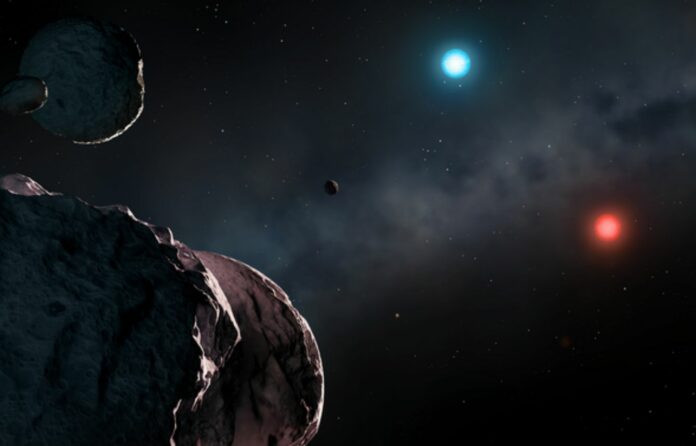A rocky and icy planetary system discovered in the Milky Way turned out to oldest planetary debris in our galaxy.
One of the oldest rocky and icy planetary systems discovered in the Milky Way, according to astronomers led by the University of Warwick, is the oldest star in our galaxy that is accreting debris from orbiting planetesimals.
The majority of stars, including our Sun, are destined to become white dwarfs. One definition of a white dwarf is an exhausted star that has shed its outer layers and is now contracting and cooling. During this process, any planets in orbit around the white dwarf will be shaken up or even destroyed, and their pieces will fall to the surface of the white dwarf.
For this study, a group of astronomers led by the University of Warwick made models of two strange white dwarfs that were found by the European Space Agency’s space observatory GAIA. Both stars are polluted by planetary debris. One of them is unusually blue, and the other is the faintest and reddest star found so far in the local galactic neighborhood. The team looked at both of them more closely.
Using spectroscopic and photometric data from GAIA, the Dark Energy Survey, and the X-Shooter instrument at the European Southern Observatory, astronomers determined that the’red’ star WDJ2147-4035 is around 10.7 billion years old, of which 10.2 billion years have been spent cooling as a white dwarf.
Spectroscopy is the process of analyzing light from a star at multiple wavelengths to discover when elements in the star’s atmosphere absorb light at distinct colors and determining what those elements are and how much of them are present. The analysis of the spectra from WDJ2147-4035 revealed the presence of sodium, lithium, and potassium, and a possible detection of carbon accreting onto the star, making it the oldest metal-polluted white dwarf known to date.
WDJ1922+0233, the second “blue” star, is only marginally younger than WDJ2147-4035 and was contaminated by planetary material with a composition close to the continental crust of Earth. The scientists found that WDJ1922+0233’s blue color, despite its cold surface temperature, is caused by its rare mixed helium-hydrogen atmosphere.
The debris discovered in the otherwise nearly pure-helium and high-gravity atmosphere of the red star WDJ2147-4035 is from an old planetary system that survived the star’s evolution into a white dwarf, leading astronomers to conclude that this is the Milky Way’s oldest planetary system discovered around a white dwarf.
According to lead author Abbigail Elms, “these metal-polluted stars show that Earth isn’t unique, there are other planetary systems out there with planetary bodies similar to the Earth.
“97% of all stars will become a white dwarf and they’re so ubiquitous around the universe that they are very important to understand, especially these extremely cool ones.
“Formed from the oldest stars in our galaxy, cool white dwarfs provide information on the formation and evolution of planetary systems around the oldest stars in the Milky Way.
“We’re finding the oldest stellar remnants in the Milky Way that are polluted by once Earth-like planets. It’s amazing to think that this happened on the scale of ten billion years, and that those planets died way before the Earth was even formed.”
Using the star’s spectra, astronomers can also estimate how quickly these metals are sinking into the star’s core, allowing them to determine how prevalent each of these metals was in the original planetary body. We can guess what those planets were like before the star died and turned into a white dwarf by comparing their abundances to those of astronomical bodies and planetary material in our own solar system. However, this has been hard to do in the case of WDJ2147-4035.
“The red star WDJ2147-4035 is a mystery as the accreted planetary debris are very lithium and potassium rich and unlike anything known in our own solar system,” explains Abbigail.
“This is a very interesting white dwarf as its ultra-cool surface temperature, the metals polluting it, its old age, and the fact that it is magnetic, makes it extremely rare.
“When these old stars formed more than 10 billion years ago, the universe was less metal-rich than it is now, since metals are formed in evolved stars and gigantic stellar explosions, adds University of Warwick’s professor pier-Emmanuel Tremblay.
“The two observed white dwarfs provide an exciting window into planetary formation in a metal poor and gas-rich environment that was different to the conditions when the solar system was formed.”
Source: 10.1093/mnras/stac2908
